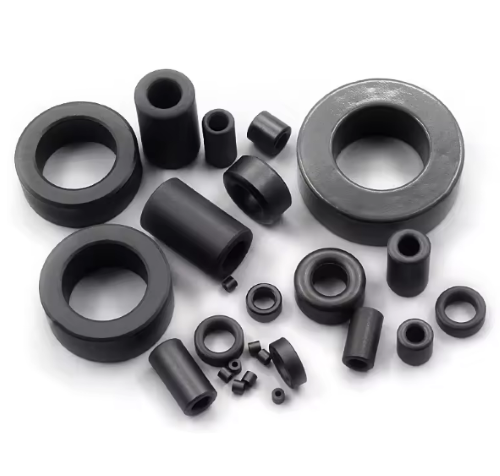Ferrite Magnets: A Comprehensive Guide
Introduction
Ferrite magnets, also known as ceramic magnets, are one of the most widely used types of permanent magnets due to their affordability, durability, and versatility. Composed primarily of iron oxide mixed with either strontium or barium carbonate, ferrite magnets are a cost-effective solution for a broad range of applications, from household items to industrial uses. This guide provides a comprehensive overview, covering their properties, manufacturing processes, types, and common applications.

Properties and Features
Ferrite magnets are characterized by their distinct magnetic and physical properties, which make them suitable for various applications:
- Magnetic Strength: Ferrite magnets have moderate magnetic strength, with a typical maximum energy product (BHmax) ranging from 1 to 4.5 Mega Gauss Oersteds (MGOe). While they are not as strong as neodymium magnets, their magnetic strength is sufficient for many everyday applications.
- Durability: These magnets are known for their excellent durability. They are highly resistant to demagnetization, corrosion, and oxidation, making them ideal for use in environments where they may be exposed to moisture, chemicals, or extreme temperatures.
- Temperature Stability: One of their key advantages is their ability to maintain their magnetic properties at high temperatures. They can function effectively at temperatures up to 250°C (482°F), which makes them suitable for applications that involve heat.
- Brittleness: Ceramic magnets are relatively brittle, meaning they can break or chip if subjected to a strong impact or excessive force. However, this brittleness is generally not an issue in most applications where the magnets are properly handled and secured.
Manufacturing Process
The production of ferrite magnets involves several key steps, which contribute to their widespread availability and low cost:
- Powder Preparation: The manufacturing process begins with the preparation of fine powders of iron oxide and either strontium or barium carbonate. These powders are mixed in precise proportions to achieve the desired magnetic properties.
- Calcination: The mixed powders are then calcined, which involves heating them to a high temperature to initiate a chemical reaction that forms ferrite. This process produces a fine, homogeneous powder.
- Pressing: The calcined powder is pressed into a desired shape using a high-pressure mold. This step creates a compacted “green” magnet, which is not yet fully magnetized.
- Sintering: The pressed magnet is then sintered at high temperatures in a furnace. During sintering, the material is heated to just below its melting point, causing the particles to fuse together and form a solid, dense magnet.
- Magnetization: After sintering, the magnet is cooled and then magnetized by exposing it to a strong magnetic field. This step aligns the magnetic domains within the material, giving the magnet its permanent magnetic properties.
Types of Ferrite Magnets
Ferrite magnets can be classified into two main types based on their magnetic properties:
- Hard ferrite magnets are made from a mixture of iron oxide and either strontium or barium carbonate. These magnets have a high coercivity, meaning they are difficult to demagnetize. This makes them ideal for permanent magnet applications where a stable magnetic field is required over time. They are commonly used in motors, loudspeakers, magnetic separators, and refrigerator magnets.
- Soft ferrite magnets (Electromagnetic Cores) are typically made from iron oxide combined with other metal oxides such as manganese or zinc. These magnets have low coercivity, meaning they can be easily magnetized and demagnetized. They also have high electrical resistivity, which reduces eddy current losses in alternating magnetic fields. They are used in electromagnetic cores for transformers, inductors, antennas, and other electronic components that operate in high-frequency environments.
Related reading: Soft Ferrites VS Hard Ferrites
Common Applications
Ferrite magnets are widely used in a variety of applications due to their cost-effectiveness and reliable performance:
- Motors and Generators: They are commonly used in electric motors and generators, where they provide the necessary magnetic fields for converting electrical energy into mechanical energy and vice versa. Their durability and temperature stability make them suitable for use in demanding industrial environments.
- Loudspeakers: They are used in the magnets of loudspeakers to create the magnetic field that drives the speaker cone. This allows for the production of sound in a wide range of audio devices, from small portable speakers to large home theater systems.
- Magnetic Separators: In industries such as mining and recycling, ceramic magnets are used in magnetic separators to remove ferrous materials from non-ferrous materials. Their resistance to corrosion and high-temperature environments makes them ideal for these heavy-duty applications.
- Refrigerator Magnets: These magnets are also used in everyday items like refrigerator magnets. Their low cost and sufficient magnetic strength make them a popular choice for this application.
- Electronic Components: Soft ferrite magnets are used in the cores of transformers, inductors, and antennas, where they help to manage and direct magnetic fields in electronic circuits.
Conclusion
Ferrite magnets are used in household items like refrigerator magnets or in industrial applications like electric motors and magnetic separators thanks to their affordability, durability, and versatility. Understanding the properties, types, and manufacturing processes can help you make informed decisions when selecting magnets for your specific needs. For more magnet products, please check Stanford Magnets